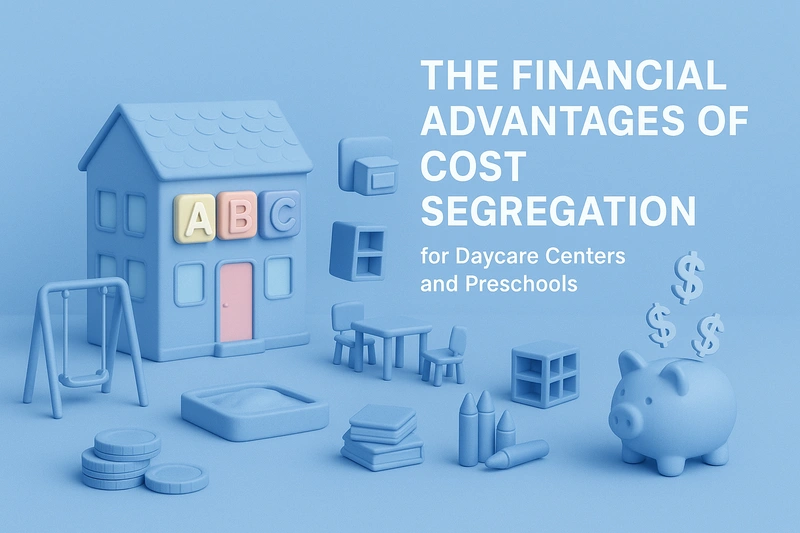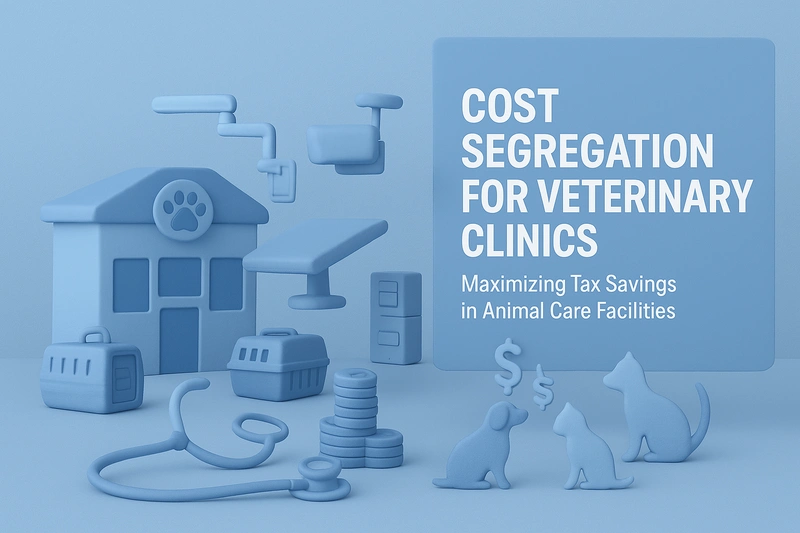A 50-unit apartment building purchased for $5 million could generate $500,000 in immediate tax savings. This isn't aggressive tax planning or a questionable strategy. It's cost segregation, an IRS-approved method that transforms apartment buildings into powerful tax-advantaged investments.
The Big Beautiful Bill changed everything for multifamily investors. Properties acquired after January 19, 2025, qualify for 100% bonus depreciation on accelerated components. This means 25-35% of your apartment building's purchase price becomes an immediate tax deduction. The previous phase-out that dropped bonus depreciation to 60% in 2024 has been reversed. The window for maximum benefits is open now.
Legislative Context: 2025 Bonus Depreciation Revival
Congress restored 100% bonus depreciation at a critical moment. After declining from 100% in 2022 to 80% in 2023 and 60% in 2024, the scheduled 40% rate for 2025 has been replaced with full immediate expensing. This legislative shift creates unprecedented opportunity for apartment building acquisitions.
Multifamily properties hold unique advantages in this environment. While office and retail buildings depreciate over 39 years, apartment buildings follow a 27.5-year schedule. With engineering-based cost segregation services, that timeline compresses dramatically. Components representing 25-35% of building value qualify for immediate deduction.
Smart investors are moving quickly. Every apartment building acquired now through year-end maximizes these benefits. The following analysis shows exactly why multifamily properties deliver superior tax advantages over any other real estate asset class.
Understanding Multifamily Cost Segregation Fundamentals
Multifamily properties hold a distinct advantage in cost segregation studies. Unlike office buildings that depreciate over 39 years, apartment buildings follow a 27.5-year schedule. This faster baseline depreciation becomes even more powerful when cost segregation identifies components eligible for accelerated depreciation.
The scale factor sets multifamily apart. A 50-unit apartment complex contains 50 kitchens and 50 sets of appliances. Each qualifies for accelerated depreciation. This multiplication effect creates substantial tax savings unavailable to single-family investors managing scattered portfolios.
Common areas add another layer of opportunity. Leasing offices, fitness centers, pools, and clubhouses contain significant 5-year and 15-year property. These amenity-rich spaces often represent 10-15% of total building value in modern multifamily properties.
Breaking Down the Components
Cost segregation services identify four primary depreciation categories in apartment buildings:
5-Year Property:
- Kitchen appliances
- Carpeting and vinyl flooring
- Window treatments
- Removable light fixtures
- Cabinetry hardware
- Communication systems
7-Year Property:
- Office furniture in leasing centers
- Maintenance equipment
15-Year Property:
- Parking lots and sidewalks
- Landscaping and irrigation
- Fencing and security gates
- Site lighting
27.5-Year Property:
- Building structure
- Permanent HVAC systems
- Plumbing and electrical
What percentage of my apartment building qualifies for accelerated depreciation?
Apartment buildings typically see 20-35% of purchase price reclassified to shorter recovery periods. Properties with extensive amenities, recent renovations, or lower land value allocations often exceed 35%. Engineering-based studies determine exact percentages through detailed component analysis.
The Multifamily Advantage - Asset Class Specific Benefits
Multifamily properties generate superior cost segregation results through repetitive components. While single-family investors must conduct separate studies for each property, apartment building owners capture all units in one comprehensive analysis.
R.E. Cost Seg typically charges one study fee regardless of unit count, making the per-door cost negligible for larger properties.
The unit multiplication effect drives exceptional returns. Consider 50 refrigerators at $800 each. That's $40,000 in 5-year property from one component type. Add dishwashers, ranges, disposals, and microwave ovens. The appliance category alone can exceed $100,000 in accelerated depreciation.
Financial Example: 50-Unit Apartment Complex
Purchase Breakdown:
- Purchase Price: $5,000,000
- Land Value: $1,000,000 (20%)
- Depreciable Basis: $4,000,000
Without Cost Segregation:
- Annual depreciation: $145,455
- 10-year depreciation total: $1,454,550
- Tax savings at 37%: $538,184 over 10 years
With Cost Segregation Services:
- 5-year property (25%): $1,000,000
- 15-year property (10%): $400,000
- 27.5-year property (65%): $2,600,000
First-Year Results with 100% Bonus Depreciation:
- Total depreciation: $1,489,091
- Tax savings: $550,964
- Additional cash flow versus standard depreciation: $497,173
This cash injection funds additional acquisitions, renovations, or debt reduction. The Big Beautiful Bill's restoration of 100% bonus depreciation multiplies these benefits for properties acquired after January 19, 2025.
Competitive Asset Class Comparison
Multifamily properties outperform other commercial real estate in cost segregation studies:
- Multifamily: 27.5-year base depreciation, 25-35% typical reclassification
- Office Buildings: 39-year base depreciation, 15-25% typical reclassification
- Retail Centers: 39-year base depreciation, complicated by tenant improvements
- Industrial: 39-year base depreciation, 10-20% typical reclassification
How does apartment building depreciation compare to other commercial properties?
Apartment buildings depreciate 42% faster than commercial properties before cost segregation. After our studies, multifamily properties typically achieve 30-50% higher first-year depreciation than office or retail properties of similar value.
Advanced Strategies for Different Investor Types
Passive Loss and Real Estate Professional Status
Cost segregation benefits vary based on investor tax status. Understanding these distinctions maximizes your depreciation strategy.
Passive Investors: Most multifamily investors face passive activity loss limitations. Depreciation from cost segregation offsets rental income and other passive investments. Excess losses carry forward indefinitely. Many investors accumulate these losses strategically, using them to offset future property sales or passive income streams.
Real Estate Professional Status: Meeting the 750-hour annual requirement and material participation tests unlocks significant advantages. Real estate professionals use cost segregation losses against W-2 income, business income, and investment gains. This status transforms apartment building depreciation into a comprehensive tax shelter.
Short-Term Rental Strategy: Operating units as furnished short-term rentals with average stays under seven days can qualify as active business income. When combined with material participation, investors offset ordinary income without real estate professional status.
Syndication and Partnership Considerations
Cost segregation in syndicated deals requires careful structuring. Depreciation typically flows through based on ownership percentages, but partnership agreements can specify special allocations.
Key Syndication Elements:
- Limited partners receive pro-rata depreciation pass-through on K-1s
- General partners often negotiate additional depreciation allocations
- Depreciation timing affects investor returns and capital account balances
- Form 3115 filing requirements apply to all partners claiming catch-up depreciation
R.E. Cost Seg coordinates with syndication attorneys and CPAs to optimize allocations. Proper structuring ensures all partners maximize their tax positions.
How is cost segregation depreciation allocated among syndication partners?
Standard partnership agreements allocate depreciation by ownership percentage. However, special allocations can direct more depreciation to partners who benefit most, provided they meet substantial economic effect requirements.
Maximizing Your Multifamily Cost Segregation Study
Strategic Timing Considerations
Timing determines your cost segregation success. The Big Beautiful Bill's restoration of 100% bonus depreciation creates a critical window for multifamily investors.
New Acquisitions: Properties acquired and placed in service after January 19, 2025, qualify for 100% bonus depreciation. Schedule your site visit immediately after closing to maximize current-year benefits. R.E. Cost Seg completes studies within three weeks, ensuring you capture full depreciation for tax filing.
Look-Back Studies: Properties acquired in prior years remain eligible through Form 3115 filing. This automatic accounting method change captures missed depreciation without amending returns. The catch-up adjustment hits your current year return, creating substantial immediate deductions.
Value-Add Timing: Complete renovations before commissioning your study. Including improvement costs increases your depreciable basis and qualified components. A $500,000 renovation can add $150,000 or more in accelerated depreciation.
Components Unique to Multifamily Properties
Modern apartment buildings contain extensive 5-year and 15-year property. Cost segregation engineers identify components often missed by generic studies.
Standard Per-Unit Components:
- Kitchen appliances and specialized electrical
- Carpet, vinyl, and removable flooring
- Window blinds and treatments
Emerging Multifamily Technologies:
- Smart locks and access control systems
- Package locker systems
- USB outlets and charging stations
- High-speed internet infrastructure
- Security cameras and monitoring equipment
Common Area Opportunities:
- Fitness equipment and rubber flooring
- Pool furniture and equipment
- Playground structures
- Dog park improvements
- Outdoor kitchen appliances
- Business center computers and furniture
Land value allocation significantly impacts results. Properties with 15-20% land value generate better cost segregation outcomes than those with 30-40% land allocations.
Should I wait for renovations to complete before the study?
Yes. Completing renovations first maximizes your depreciable basis. R.E. Cost Seg can perform separate studies for acquisition and renovation phases if needed, but combining them reduces costs and simplifies tax filing.
Exit Strategy and Risk Management
Managing Depreciation Recapture
Depreciation recapture concerns prevent many investors from pursuing cost segregation. This fear is typically overblown. Proper planning ensures tax benefits exceed recapture costs.
Recapture Mechanics:
- Section 1245 property (5-year and 7-year): Recaptured as ordinary income
- Section 1250 property (15-year and 27.5-year): Recaptured at 25% rate
- Only triggered upon property sale
- No recapture if property transfers via 1031 exchange
Time Value Analysis: A $500,000 first-year tax saving invested at 8% grows to $734,664 over five years. Even with full recapture at sale, you keep the investment gains. Most investors find the arbitrage profitable after three years.
1031 Exchange Integration
Cost segregation combines powerfully with 1031 exchanges. Taking accelerated depreciation now while deferring recapture indefinitely through exchanges maximizes wealth accumulation.
Exchange Considerations:
- Complete cost segregation before identifying replacement property
- Replacement property should contain similar or greater 1245 property
- Basis adjustment calculations become complex
- Professional guidance essential for compliance
Audit Defense and Compliance
R.E. Cost Seg studies withstand IRS scrutiny through engineering-based methodology. Our reports follow the IRS Cost Segregation Audit Technique Guide requirements.
Documentation Standards:
- Detailed engineering analysis
- Component-by-component pricing
- Photo documentation from site visits
- American Society of Testing and Materials guidelines
- Full audit support included
Common Audit Triggers to Avoid:
- Using percentage estimates without engineering basis
- Aggressive land value manipulation
- Inconsistent treatment across similar properties
What happens to my tax benefits if I sell the property in five years?
You'll face depreciation recapture, but the time value of money typically ensures profitability. A $100,000 tax saving invested for five years at reasonable returns exceeds recapture costs. Using a 1031 exchange eliminates immediate recapture entirely.
Regional and Market-Specific Considerations
Geographic Factors
Location impacts cost segregation results through land value variations. High-cost markets like San Francisco or Manhattan often carry 40-50% land value allocations, reducing depreciable basis. Secondary markets typically maintain 15-25% land values, maximizing depreciation opportunities.
State Tax Implications:
- California: 13.3% top rate amplifies federal benefits
- Texas: No state income tax, federal benefits only
- New York: Combined rates exceed 50%, doubling study value
R.E. Cost Seg adjusts land value allocations based on local assessments and appraisals, ensuring IRS compliance while maximizing benefits.
Special Property Types
Different multifamily categories present unique opportunities:
- Affordable Housing: Section 42 properties qualify for cost segregation. Combining with Low-Income Housing Tax Credits multiplies benefits. Compliance restrictions don't affect depreciation eligibility.
- Student Housing: Per-bed leasing and furnished units increase 5-year property. Common areas often represent 25% of building value.
- Senior Living: Assisted living facilities with services may qualify as commercial property (39-year). Independent living follows standard multifamily rules.
Can I perform cost segregation on affordable housing properties?
Yes. Affordable housing properties receive identical cost segregation treatment. Combined with LIHTC and other incentives, total tax benefits often exceed 40% of building cost.
Common Pitfalls and How to
Avoid Them
Mistakes to Avoid
Investors lose thousands in tax benefits through preventable errors. R.E. Cost Seg helps clients avoid these common mistakes:
Critical Errors:
- Using online calculators or percentage estimates instead of engineering studies
- Missing Form 3115 deadlines for look-back studies
- Incorrectly allocating land value without proper documentation
- Commissioning studies after selling property
- Failing to coordinate with CPAs before year-end
Documentation Failures:
- Lost closing statements
- Missing renovation invoices
- Incomplete property records
- No photo documentation
Proper planning prevents these issues. Engage cost segregation services immediately after property acquisition. Maintain complete records. Coordinate with tax professionals early. Our engineering team guides you through requirements, ensuring IRS compliance and maximum benefits.
The Bottom Line: Why Apartment Buildings Are Tax Gold Mines
Multifamily properties deliver unmatched cost segregation benefits. The combination of 27.5-year base depreciation, repetitive unit components, and extensive common areas creates exceptional tax savings.
With 100% bonus depreciation restored through the Big Beautiful Bill, apartment building owners can convert 25-35% of their purchase price into immediate tax deductions.
The numbers prove the opportunity. A typical $5 million apartment complex generates $500,000 or more in first-year tax savings. Study costs of $5,000-$10,000 produce 50-100x returns. No other tax strategy delivers comparable immediate cash flow improvement.






